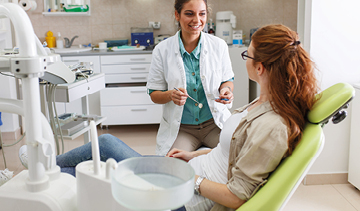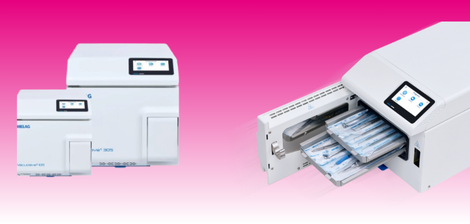Your dental chair is one of the most important pieces of equipment in your practice. But, if you had to replace or upgrade it, would you know where to start?
Packed full of the latest engineering, ergonomics, design and technology there is a lot to consider, which is why we’ve developed our Top Tips to guide you to the right dental chair for you, your practice and your patients.
Prior to the 17th Century, tooth extractions were often performed with patients sitting on the floor, their heads held firmly between the dentist’s knees. Not the most comfortable situation for the patient or clinician. Thankfully, famous dental surgeon, Pierre Fauchard changed that by becoming the first creator of ‘the dental chair’ – an adapted armchair that he continued to modify as he expanded his dental treatments.
Fast forward to today and dentists are overwhelmed with choice when it comes to dental chairs, but that can also present a few challenges…
Available in every colour, material and packed full of the latest engineering, ergonomics and technology it can be hard to know how to choose the right dental chair for you, for your practice and of course, for your patients.
Here are our Top Tips to help you find the right dental chair for you, your practice and your patients.
Tip #1 Research = peace of mind
There is a lot to consider before you purchase a dental chair. It’s the heart of a practice and one of the most used pieces of kit you’ll own.
When it comes to purchasing your first, second, third or tenth dental chair, it’s important to do your research once you’ve found something you’re interested in.
Make sure that both the manufacturer and seller have proven track records. You can check this by reviewing customer ratings online, looking at the length of their trading history and by asking your peers about their experiences of dealing with them.
Buying second-hand from online sites such as eBay may offer huge discounts. But it can also be fraught with problems that could result in costly repair bills and cancel out any initial savings. Add in the fact there is no warrantee to protect you and that you could be buying counterfeit goods, which put your patients at risk and you can see why it’s a bad idea.
I can’t overstate enough the importance of always buying from a reputable supplier and brand.
It’s also worth researching the dental chair’s warranty period – around five years is considered the norm – and extended warranties are a good option for dental chairs too.
Check where the manufacturer and supplier’s service departments are located. You always want this to be in the UK, otherwise you’ll struggle with long waiting times for repair should anything go wrong.
Tip #2 Are you sitting (and working) comfortably?
The technology packed into a dental chair and how it looks are important, but if it’s not comfortable for both you and the patient it’s never going to work for your practice.
A good dental chair should allow you to work ergonomically and safely. It needs to give you full access to your patients, manoeuvre easily into the correct position, have foot control pedals to free up your hands and a double-articulated headrest which enables you to alter the dental chair’s height and adjust to patients’ body shape and weight.
For longer treatments, such as endodontic or implant work, or for patients who suffer with dental phobia or anxiety, extra comfort is clearly key, so you should look at different types of upholstery, the benefit of hydraulic and fully adjustable speed control and the smoothness of transition during adjustments.
Tip #3 Right or left?
If the chair is going to be used by more than one practice team member you should ask whether you have a mix of left and right-handed clinicians. If you do, an ambidextrous chair offers a good solution to meet everyone’s needs.
Tip #4 the hygiene factor
A well-designed dental chair will help reduce the risk of cross-contamination. Foot pedals provide ‘hands-free’ chair controls, automatic flushing systems helps keep the treatment area clean and seamless upholstery makes it easier to clean.
Tip #5 looks are important too
Once you’re confident you’ve found a dental chair that will fulfil all your practical needs, you can now start to look at aesthetics. The look and feel of your practice is important for patients and your team – it helps motivate staff and creates a calming environment for your patients.
In fact, a dental chair is often the first thing a patient sees when they walk into a surgery.
If you treat a number of patients with anxiety it may be worth considering colour psychology and how your choice can positively impact their experience with you. For example, blue is believed to be calming and green shades promote feelings of rest.
Tip #6 ask…
My final tip is a simple one – ask for help and advice.
Just one dental chair can cost up to £40,000 so you need to feel confident the chair you order is right for you and your practice as well as knowledgeable about its functionality.
We speak to practices daily and talk them through the process of upgrading or replacing their chairs. We know it’s a service they value. Dentists tell me there’s simply too much choice – I tell them the choice is better than reverting to patents in modified armchairs.
We’re able to talk customers through their options, the servicing agreements and repair process to help them keep their dental chair in the best of health. If cared for, a dental chair can last up to 10 years – I’ve even seen some that are more than 30 years old.
At DD we sell and subsequently service hundreds of dental chairs, so we can offer impartial advice to help make your purchasing decision easier and also advise on the best maintenance and servicing agreement to keep your investment in good health and your practice running smoothly.
DD has a dedicated equipment department which supplies, installs and maintains everything from dental chairs and cabinetry through to the latest digital imaging systems and specialist product catalogues featuring orthodontic, oral hygiene and facial aesthetic product ranges.
It was founded almost 45 years ago and now employs over 600 people across the UK, including a state-of-the-art automated warehouse at the head office in Witham, Essex, which houses more than 27,000 product lines.



